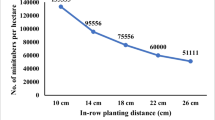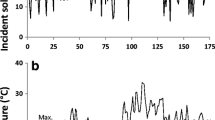Abstract
Four microplant planting densities (PD) for greenhouse production of minitubers of three varieties were used to assess the agronomic and economic efficiencies of increased PD compared to the baseline density (63 microplants m−2). The field performance of minitubers was also included in the agronomic (yield formation) efficiency assessment of minitubers production. The concept of a field value (FV) of greenhouse area and of microplant was introduced. Economic assessment of PD changes was based on partial budget analysis and the marginal rate of return between PDs in ascending order. Agronomic efficiency assessment, as an efficient utilization of greenhouse space, revealed that the number of minitubers per m2 increased gradually with increasing PD and the magnitude of the increase was up to 2.6 times between PD 63 and 184 microplants m−2 making this PD the most effective of the studied. The change in minituber number per microplant due to the increased PDs was closely related to the economic efficiency assessment. In the baseline scenario (microplant cost of 0.54 € and minituber cost of 0.41 €), only the shift from PD63 to PD95 was efficient without trade-offs for only one of three varieties.
Resumen
Se usaron cuatro densidades de siembra de microplantas (DP) para la producción en invernadero de minituberculos de tres variedades para evaluar las eficiencias agronómicas y económicas del aumento de la DP en comparación con la densidad normal (63 microplantas m -2). También se incluyó el rendimiento de campo de los minitubérculos en la evaluación de la eficiencia agronómica (formación de rendimiento) de la producción de minitubérculos. Se introdujo el concepto de valor de campo (FV) de área de invernadero y de microplanta. La evaluación económica de los cambios en la DP se basó en el análisis presupuestario parcial y la tasa marginal de rendimiento entre los PD en orden ascendente. La evaluación de la eficiencia agronómica, como una utilización eficiente del espacio del invernadero, reveló que el número de minituberculos por m 2 aumentó gradualmente con el aumento de la DP y la magnitud del aumento fue de hasta 2.6 veces entre PD 63 y 184 microplantas m -2, lo que hace que esta DP sea la más efectiva de las estudiadas. El cambio en el número de minitubérculos por microplanta debido al aumento de los PD estuvo estrechamente relacionado con la evaluación de la eficiencia económica. En el escenario de referencia (costo de la microplanta de 0.54 € y costo del minituberculo de 0.41 €), solo el cambio de PD63 a PD95 fue eficiente sin compensaciones para solo una de las tres variedades.




Similar content being viewed by others
Abbreviations
- PD:
-
Planting density of microplants in a greenhouse
- gMR:
-
Multiplication rate in a greenhouse
- fMR:
-
Multiplication rate in a field
- nMT:
-
Number of minitubers
- MtC:
-
Weight class of minitubers
- FVua :
-
Field value of greenhouse unit area
- FVivp :
-
Field value of microplant
- MRR:
-
Marginal rate of return
References
Abdulnour, J., G. Roy, and Y. Desjardins. 2003. Effect of supplemental lighting, substrate (potting mix) volume and plant densities on potato minituber production during winter greenhouse culture in Quebec. Acta Horticulturae 619: 53–58.
Barry, P., P.C. Clancy, and M. Molloy. 2001. The effect of seed size and planting depth on the yield of seed potatoes grown from minitubers. Irish Journal of Agricultural and Food Research 40: 71–81.
Boyd, E., E. Carpenter, B.T. Ross, N. Zidack, and M.L. Flenniken. 2018. Potato cultivar and seed type affect the development of systemic potato virus Y (PVYN-Wi) infection. American Journal of Potato Research 95: 183–190.
Çalışkan, M.E., C. Yavuz, A.K. Yağız, U. Demirel, and S. Çalışkan. 2021. Comparison of aeroponics and conventional potato mini tuber production systems at different plant densities. Potato Research 64: 41–53.
Calori, A.H., T.L. Factor, J.C. Feltran, E.Y. Watanabe, C.C. Moraes, and L.F.V. Purquerio. 2018. Seed potato minituber production in an aeroponic system under tropical conditions: Electrical conductivity and plant density. Journal of Plant Nutrition 41: 2200–2209.
Cho, A.H., A.W. Hodges, and C.A. Chase. 2012. Partial budget analysis of summer fallows for organic nutrient and weed management in Florida. HortTechnology 22: 258–262.
CIMMYT Economics Program. 1988. From agronomic data to farmer recommendations: An economics training manual. Mexico: CIMMYT.
Corrêa, R.M., J.E.B.P. Pinto, C.A.B.P. Pinto, V. Faquin, É.S. Reis, A.B. Monteiro, and W.E. Dyer. 2008. A comparison of potato seed tuber yields in beds, pots and hydroponic systems. Scientia Horticulturae 116: 17–20.
Dimante, I., and Z. Gaile. 2015. The effect of planting density on potato (Solanum tuberosum L.) minituber number, weight and multiplication rate. Research for Rural Development: 27–33.
Dimante, I., and Z. Gaile. 2018. Assessment of potato plant development from Minitubers. Agronomy Research 16: 1630–1641.
Dimante, I., I. Mežaka, and Z. Gaile. 2019. The effect of minituber weight on their field performance under a northern european environment. Agronomy Research 17: 396–407.
Espinosa, A.P., C. Crissman, and A. Hibon. 1996. Accounting for seed potato production costs: A computer spreadsheet-based management tool. Lima: Fredy's Publicaciones.
Evans, E. 2005. Marginal analysis: an economic procedure for selecting alternative technologies/practices. EDIS 7. https://edis.ifas.ufl.edu/pdffiles/FE/FE56500.pdf Accessed 14 April 2021.
Farran, I., and A.M. Mingo-Castel. 2006. Potato minituber production using aeroponics: Effect of plant density and harvesting intervals. American Journal of Potato Research 83: 47–53.
Forbes, G.A., A. Charkowski, J. Andrade-Piedra, M.L. Parker, and E. Schulte-Geldermann. 2020. Potato seed systems. In The potato crop, 431–447. Cham: Springer International Publishing.
Grigoriadou, K., and N. Leventakis. 1999. Large scale commercial production of potato minitubers, using in vitro techniques. Potato Research 42: 607–610.
Guenthner, J.F., A. Charkowsi, R. Genger, and G. Greenway. 2014. Varietal differences in minituber production costs. American Journal of Potato Research 91: 376–379.
Halterman, D.A., A.O. Charkowski, and J. Verchot. 2012. Potato , viruses , and seed certification in the USA to provide healthy propagated tubers. Pest technology 6: 1–14.
Horton, D. 1982. Partial budget analysis for on-farm potato research. Lima: CIP.
Hutchinson, E. 2006. Principles of microeconomics. Victoria: Universiry of Victoria.
Kawakami, T., H. Oohori, and K. Tajima. 2015. Seed potato production system in Japan, starting from foundation seed of potato. Breeding Science 65: 17–25.
Lommen, W.J.M. 1999. Causes for low tuber yields of transplants from in vitro potato plantlets of early cultivars after field planting. The Journal of Agricultural Science 133: 275–284.
Lommen, W.J.M., and P.C. Struik. 1992. Production of potato minitubers by repeated harvesting: Effects of crop husbandry on yield parameters. Potato Research 35: 419–432.
Mateus-Rodriguez, J.R., S. de Haan, J.L. Andrade-Piedra, L. Maldonado, G. Hareau, I. Barker, C. Chuquillanqui, V. Otazú, R. Frisancho, C. Bastos, A.S. Pereira, C.A. Medeiros, F. Montesdeoca, and J. Benítez. 2013. Technical and economic analysis of aeroponics and other systems for potato mini-tuber production in latin America. American Journal of Potato Research 90: 357–368.
Milinkovic, M., C.B. Horstra, B.C. Rodoni, and M.E. Nicolas. 2012. Effects of age and pretreatment of tissue-cultured potato plants on subsequent minituber production. Potato Research 55: 15–25.
Özkaynak, E., and B. Samanci. 2006. Field performance of potato minituber weights at different planting dates. Archives of Agronomy and Soil Science 52: 333–338.
Pożoga, M., D. Olewnicki, and L. Jabłońska. 2019. In vitro propagation protocols and variable cost comparison in commercial production for paulownia tomentosa × paulownia fortunei hybrid as a renewable energy source. Applied Sciences 9: 2272.
Ritter, E., B. Angulo, P. Riga, C. Herrán, J. Relloso, and M. San Jose. 2001. Comparison of hydroponic and aeroponic cultivation systems for the production of potato minitubers. Potato Research 44: 127–135.
Roy, R.D., V.S. Machado, S.M.M. Alam, and A. Ali. 1995. Greenhouse production of potato (Solanum tuberosum L. cv. Désirée) seed tubers using in vitro plantlets and rooted cuttings in large propagation beds. Potato Research 38: 61–68.
Rykaczewska, K. 2016a. The potato minituber production from microtubers in aeroponic culture. Plant, Soil and Environment 62: 210–214.
Rykaczewska, K. 2016b. Field performance of potato minitubers produced in aeroponic culture. Plant, Soil and Environment 62: 522–526.
Rykbost, K.A., and B.A. Charlton. 2004. Effects of prenuclear minituber seed size on production of Wallowa russet seed. Research in the Klamath Basin Annual Report: 38–43.
Struik, P.C. 2007. The canon of potato science: 25. Minitubers. Potato Research 50: 305–308.
The Jamovi Project. 2021. https://www.jamovi.org. Accessed 1 Aug 2021.
Tierno, R., A. Carrasco, E. Ritter, and J.I.R. de Galarreta. 2014. Differential growth response and minituber production of three potato cultivars under aeroponics and greenhouse bed culture. American Journal of Potato Research 91: 346–353.
Tigner, R. 2018. Partial budgeting: Making incremental farm business changes. University of nebraska-lincoln extension: Cornhusker Economics.
UNECE Standard S-1. 2018. UNECE Standard S-1 concerning the marketing and commercial quality control of seed potatoes. http://www.unece.org/fileadmin/DAM/trade/agr/promotion/Brochures/SeedPotatoes/LowResolution_English.pdf. Accessed 19 July 2021.
van der Veeken, A.J.H., and W.J.M. Lommen. 2009. How planting density affects number and yield of potato minitubers in a commercial glasshouse production system. Potato Research 52: 105–119.
Virtanen, E., and J. Tuomisto. 2016. Hydroponic minituber production in growth room conditions and carry-over effects of the technique on produced minitubers. Journal of Agricultural Science 9: 41.
Wang, B., Y. Ma, Z. Zhang, Z. Wu, Y. Wu, Q. Wang, and M. Li. 2011. Potato viruses in China. Crop Protection 30: 1117–1123.
Acknowledgments
Special thanks to Dr.ir. W.J.M. Lommen (WUR) for the idea to create a field value concept and to Dr.agr. I.Skrabule (AREI) for her assistance in organizing the field trials and valuable advices during data collection.
Funding
This paper was prepared with the support of the European Social Fund as part of project Nr.8.2.2.0/20/I/001.
Author information
Authors and Affiliations
Corresponding author
Rights and permissions
About this article
Cite this article
Dimante, I., Gaile, Z., Cerina, S. et al. High Microplant Densities in Greenhouses – Are they Always Efficient in Small Potato Minituber Production Systems?. Am. J. Potato Res. 99, 243–257 (2022). https://doi.org/10.1007/s12230-022-09876-1
Accepted:
Published:
Issue Date:
DOI: https://doi.org/10.1007/s12230-022-09876-1




